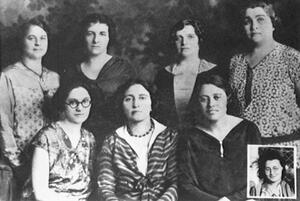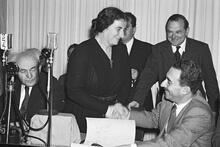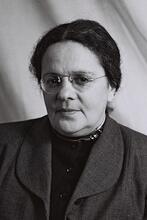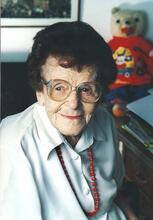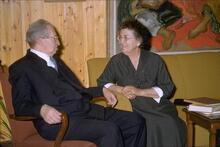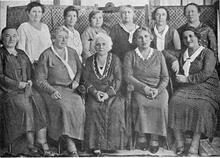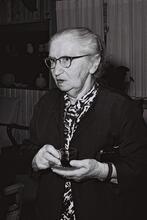Pioneer Women in the United States
The Women's Organization for the Pioneer Women of Palestine was officially founded in 1925. (It changed its name to Pioneer Women in 1939 and is today called Na'amat.) This early photograph of its leaders includes (L to R, standing): Leah Brown, Goldie Meyerson (Golda Meir), Miriam Meltzer and Nina Zuckerman; (seated): Leah Biskin, Rahel Siegel, Fiegel Berkinblitt. Insert: Chaya Ehrenreich.
Institution: Private collection
Pioneer Women was created in the United States in 1925 to help the pioneer women’s cooperatives in Palestine through American-based philanthropic efforts. The group was distinguished in the American context by the fact that it alone served as a channel for Jewish immigrant women who sympathized with aims and ideals of the labor movement in Palestine. It also provided a unique foothold for many Zionist leaders in the decades before the cause of the State of Israel became an integral component of the American Jewish consensus. In more recent decades it remains the voice of Labor Zionist women on American soil and the outpost of a progressive and egalitarian Zionist vision of diaspora Jewry.
Introduction
Pioneer Women, the Labor Zionist women’s organization in the United States—today called Na’amat—was officially founded in 1925. The new group sought to elevate the public profile of the halutzot (Zionist women pioneers) in the Jewish community in Palestine prior to the establishment of the State of Israel. "Old Yishuv" refers to the Jewish community prior to 1882; "New Yishuv" to that following 1882.Yishuv (Palestine Jewish settlement community) and to help the pioneer women’s cooperatives in Palestine through American-based philanthropic efforts. Pioneer Women considered itself the sister movement in the Lit. (Greek) "dispersion." The Jewish community, and its areas of residence, outside Erez Israel.diaspora of Mo’ezet Ha-Po’alot, the Palestine women workers’ movement. It embraced the latter’s vision of “expand[ing] the boundaries of the Jewish woman’s role” in the Yishuv and “secur[ing] her full and equal participation in the process of Jewish national reconstruction.”
Pioneer Women also emphasized the importance of women in the American Zionist enterprise and provided a forum for working-class Jewish immigrant women who sympathized with the aims and ideals of socialist Zionism and the nascent Yishuv. In time, the organization opened up new channels of communication between the Palestine labor movement and the Jewish community in America. It became a significant force in American Jewish life and played a central role in American Zionism in the decades preceding the establishment of the State of Israel in 1948.
The Work of Mania Shochat
“The entire movement here is worthless!” lamented the Zionist leader Mania Shochat in 1921. Thus Shochat, a member of the first Histadrut (General Federation of Jewish Workers in the Land of Israel) delegation to the United States, described the American branch of Po’alei Zion (Workers of Zion), an offshoot of the Russian socialist Zionist Party. Shochat decried the inactivity of the local party and informed her Palestine comrades that the American movement was but a “tempest in a teacup.” Under current circumstances, she advised, the American party could not be depended upon to promote investment in Palestine. Additionally, as she quickly discovered, any fund-raising conducted by Histadrut delegates inadvertently competed with the American movement’s existing drive to send tools and farm machinery to the Palestinian A voluntary collective community, mainly agricultural, in which there is no private wealth and which is responsible for all the needs of its members and their families.kevuzah (workers’ colonies) as well as the World Zionist Organization’s ongoing Keren Heyesod (Palestine Foundation) campaign.
In order to avoid overtaxing the American party’s scarce resources, Shochat created an ad hoc committee of female Po’alei Zion members to raise ten thousand dollars worth of kitchen and laundry equipment for the struggling kevuzah in Palestine. The women’s committee elicited the interest of a cadre of female Zionist activists who worked hard to achieve their fund-raising goal. Neither the campaign nor the committee, however, was a top priority for Shochat. In fact, she devoted most of her energy to clandestine efforts to procure weapons for Ha-Shomer (The Watchman), the Jewish self-defense organization of the Palestine labor movement. Nonetheless, Shochat’s efforts did lay the groundwork for the creation of Pioneer Women three years later.
From Tree Nurseries to Labor Zionist Women’s Organization
In 1924, when the Zionist leader Rahel Yanait (later Rahel Ben-Zvi) sought American Jewish financial support, she turned to the women who previously participated in the ad hoc committee organized by Shochat. Yanait was director of a girls’ agricultural school and tree nursery near the Ratisbonne monastery in Jerusalem. The nursery was one of several such projects organized by the Palestine labor movement. Yanait requested financial assistance for the construction of a well. The Mandate administration, which implemented Britain’s irregular policies in Palestine, severely curtailed the water supply available to the nursery.
Yanait drew up plans for a well with the assistance of the Jewish National Fund, the Zionist agency responsible for land acquisition and development in the Yishuv. Next she enlisted the support of Sophie Udin and six other Po’alei Zion activists: Eva Berg, Leah Brown, Chaya Ehrenreich, Luba Hurwitz, Rahel Siegel, and Nina Zuckerman. The women recognized the potent political value of such an undertaking for the Palestine labor movement. They also sought to exploit Yanait’s call for help in order to assert their own agenda within the male-dominated Po’alei Zion Party. Like many of their contemporaries who experienced the swift social, economic, and political transformation of American women in the 1920s, the cohort grouped around Udin reasoned that their objectives would be best advanced through an autonomous Labor Zionist women’s organization. To this end, on March 8, 1924, they published a carefully crafted letter written by Yanait in Der Tog (The day). In the letter, Yanait opined that “our tree nursery cannot exist without a well” and that during the previous two years “more than 130,000 saplings from our kevuzah have been planted in seventeen points in Galilee and Judaea.” The letter, in its endearing simplicity, proved highly effective. The image of Jewish female pioneers tending “saplings” and reclaiming the wilderness of the Yishuv struck a responsive chord among working-class Jewish immigrant women. Udin and her followers succeeded not only in raising an initial five hundred dollars; they also exploited the enthusiastic communal response to Yanait’s letter in order to buttress their campaign for an independent Labor Zionist women’s organization.
Po’alei Zion’s male leadership was generally opposed to the creation of a separate women’s organization. The leaders feared that such a structure would undermine the party’s credibility in the eyes of the immigrant community. Having long since “emancipated” Po’alei Zion’s female members and endowed them with equal rights, they argued there was no need to sponsor a new women’s organization. However, such specious reasoning did not deter Udin, Berg, Brown, Ehrenreich, Hurwitz, Siegel, and Zuckerman. They asserted that the minuscule number of women in Po’alei Zion—and their subservient roles as caretakers and child-care providers within the party framework—actually inhibited women from joining the movement. Only an autonomous Labor Zionist women’s organization, they believed, would enable them to assume greater responsibility for the movement and fully realize their potential.
Finally, in 1925, Udin appealed to the fifteenth annual Po’alei Zion convention to approve the formation of a separate women’s organization. “I explained, in the name of a small group of members,” she later recalled in modest but revealing terms, “our desire to be a part of the party, an organic part, but independent” (emphasis added). With the support of Mania Shochat, Rahel Yanait, Goldie Meyerson (later Golda Meir), and other key figures in Mo’ezet ha-Po’alot, the American women’s group officially seceded from Po’alei Zion.
The Creation of Pioneer Women
During the interwar period, an increasing number of American Jewish women became active in the Zionist movement. In fact, between the end of World War I and the establishment of the State in Israel in 1948, the number of women enrolled in the American Zionist movement grew tenfold, from approximately 30,000 to over 300,000. In this period, Hadassah (originally the women’s auxiliary of the Zionist Organization of America) became the largest Zionist group in the United States with 250,000 members. Meanwhile, Pioneer Women grew from 3000 to 28,000 members.
In 1926, the first convention of the newly established Women’s Organization for the Pioneer Women of Palestine was held in New York City. Leah Biskin was elected the group’s national president. The convention declared the new women’s organization to be completely autonomous in its political and educational work. It adopted a socialist Zionist platform and affiliated with the World Union of Po’alei Zion, the Socialist International, and the World Zionist Organization. The group stressed the importance of ideological and political tasks over philanthropic activities. The convention articulated the following goals: (1) to help create a homeland in Palestine based on cooperation and social justice; (2) to give moral and material support to the Mo’ezet ha-Po’alot; and (3) to strive through systematic cultural and propaganda work to educate the American Jewish woman to a more conscious role as coworker in the establishment of a better and more just society in America and throughout the world.
At the outset, Pioneer Women—the organization was officially renamed in 1939—mobilized twenty clubs with 900 members. The movement’s ranks were initially comprised of Yiddish-speaking immigrant women who possessed an exceptional esprit de corps. These idealistic, committed, and liberal young working women made time for political and fund-raising activities for girls’ agricultural training schools in Petah Tikvah, Nahalat Yehudah, and Haderah, places most of them never expected to see themselves.
In contrast to other American Jewish women’s organizations, Pioneer Women stressed a philosophical orientation attuned to the Jewish immigrant milieu. The organization upheld the notions of yiddishkeit (Jewishness), class consciousness, and feminism as its central values. Moreover, Pioneer Women’s membership, deeply proud of its cultural identity, shunned what it perceived to be the bourgeois trappings of Americanized groups like Hadassah and the National Council of Jewish Women. Pioneer Women “is not just one more organization of women,” the movement leaders proclaimed. “It is an organization of women with the distinct task of furthering the economic emancipation and the national rehabilitation of the Jewish masses.” In fact, the members of Pioneer Women worked hard to distinguish themselves from other women’s groups. Golda Meir, who was sent by Mo’ezet ha-Po’alot as an emissary to Pioneer Women from 1928 to 1929 and from 1932 to 1934, later recalled: “Suspicious of frivolity, it was a long time before the earnest women tolerated purely social gatherings where the ladies might play bridge instead of listening to a lecture on A.D. Gordon, Borochov or other socialist Zionist theoreticians.”
The Growth of Pioneer Women
Golda Meir and other leaders of the women workers’ movement in Palestine, including Beba Idelson, Hana Hisik, Rahel Katznelson-Rubashov (later Shazar), Elisheva Kaplan, and Ada Maimon, played conspicuous roles in the life of the organization in the 1930s. They spent extended time in the United States as emissaries of Mo’ezet ha-Po’alot and regularly toured Pioneer Women clubs in cities around the country, where they also promoted the Histadrut and the Zionist cause to general Jewish audiences. “They were really the soul of the organization,” recalled Dvorah Rothbard, head of Pioneer Women from 1942 to 1945. “Around them there was such a holy feeling! They were the ones who gave (Pioneer Women) content, who gave it wings, who gave it imagination.”
As the Jewish immigrant milieu steadily succumbed to the pressures and the allure of Americanization during the interwar years, Pioneer Women sought to strengthen its base by tapping the vast reservoir of potential American Jewish female support for Labor Zionism. This approach mirrored the general trend of the wider American Labor Zionist movement. With respect to Pioneer Women, however, such public relations groundwork was inadvertently laid by the International Ladies Garment Workers Union and several highly placed Hadassah members who publicly endorsed the Histadrut program in election campaigns for the Eighteenth and Nineteenth Zionist Congresses (1933 and 1935).
In the 1930s, Pioneer Women’s American leadership, together with the Palestinian shelihim, undertook a campaign aimed at both Yiddish- and English-speaking Jewish women in the United States and Canada. In 1931, for example, the organization published Vos arbeterns dertseyln (The woman worker speaks), an anthology of personal reminiscences by halutzot about their experiences in Palestine. The book included essays about the early years in several kezuvah; life in Palestine during World War I; impressions of A.D. Gordon, Rahel (Bluwstein), and other notable figures in the Yishuv; Jewish family life in agricultural colonies; and several hitherto unpublished photographs of halutzim and Jewish colonies.
The volume was so well received that in 1932, Pioneer Women published an English translation entitled The Plough Woman. The latter opened a window on Jewish life in the Palestine to a largely uninformed English-reading audience. The well-known writer and Labor Zionist advocate Maurice Samuel translated the material. Explaining the alleged profundity of “word-symbols” such as kevuzah, A voluntary collective community, mainly agricultural, in which there is no private wealth and which is responsible for all the needs of its members and their families.kibbutz, halutz, and Meshek ha-Po’alot (women’s training farm), Samuel asserted that the Yishuv revealed the “extraordinary folk-depths of the (Zionist) movement, the deep and inexhaustible sources of a renaissance which, in effect, is only at its beginning.” As Samuel’s comments imply, The Plough Woman was intended to be more than a straightforward translation of Vos arbeterns dertseyln. Appearing at the height of the Depression, a period that coincided with the Yishuv’s rapid growth and economic expansion, the volume presented a poignant alternative to the hardship and, in many instances, misery of American Jews. It pointed the way to individual fulfillment and collective redemption.
As Pioneer Women’s membership became increasingly Americanized, the organization gradually became less doctrinaire and shifted to an English-speaking orientation. The organization steadily grew, and so did the proceeds of its fund-raising campaign on behalf of Mo’ezet ha-Po’alot. In its first decade, Pioneer Women transmitted over $383,000 to Histadrut-related projects in Palestine. By 1939, it had 170 chapters in seventy cities and approximately 7000 members. Of the 170 clubs, 85 were categorized as “Yiddish-speaking” and contained 4500 members. It was nevertheless clear that the English-speaking clubs provided the point of entry for new and younger members between the ages of thirty and thirty-five, including a preponderance of recruits from outside the movement ranks.
The Broadening of Pioneer Women’s Activism
In 1941, Pioneer Women maintained 250 clubs with a total membership of 10,000. In addition to its traditional Zionist orientation and support for the Palestine labor movement, the organization now concentrated on bringing in “women from all walks of life” and imitating the social norms of other American Jewish women’s organizations. The younger acculturated members, wrote Rose Kaufman (national president from 1965 to 1969) in 1942, “like teas, attractive settings, flowers on the table, luncheons in a hotel—why not?” In a similar vein, new ventures like the Tozeret ha-Arez Consumers’ League—intended to support the Yishuv’s commercial industries—gradually replaced the strident political campaigns of previous decades.
But Pioneer Women did not abandon its record of social activism. During World War II, it mobilized a countrywide network of volunteers who participated in civil defense efforts, Red Cross activities, war bond sales, blood drives, salvage work, and victory gardens. Such activities demonstrated Pioneer Women’s commitment to American Jewry’s wartime efforts and enhanced the organization’s national visibility. The wartime campaign, explained the June 1944 issue of Pioneer Women, also benefited the organization by “add[ing] zest to the Eretz Israel program.” It appealed to a broad range of non-Yiddish speakers and attracted new members who previously assumed that “we were interested in only the Eretz Israel program.” In this period, when news of the destruction of European Jewry became well known, the organization also created emergency fund-raising initiatives such as the Child Rescue Fund of 1943 and the Building Fund of 1944, both of which were targeted at the needs of European Jewish refugee children in the Yishuv. After the war, the campaign was widened to include orphans and children born in displaced persons camps.
With the establishment of the State of Israel in 1948, Pioneer Women expanded the range of its American activities. It embraced a cultural educational agenda that revealed growing concern about Jewish continuity in the New World. It moderated much of its original socialist and feminist ideology as well as its philosophical and political orientation. In this way, the organization reflected the changing character and concerns of a sizable segment of American Jewish women while continuing its work with labor and progressive groups on behalf of liberal causes.
After the establishment of the State of Israel, Pioneer Women proved to be an important partner for the Labor Zionist movement in Israel as well as a key player in American Zionism. The organization worked very closely with Mo’ezet ha-Po’alot and the Jewish Agency for Israel. It promoted American Jewish tourism to the new state, conducted numerous independent and collaborative fund-raising campaigns, spearheaded efforts on behalf of vocational and educational centers for Jewish and Arab women and girls, helped create a vast network of day-care centers for Israeli working families, actively participated in Zionist political affairs, and served as a conduit to American Jewish society for Israel’s rising women’s movement. On the American front, too, Pioneer Women assumed responsibility for a multiplicity of Labor Zionist causes that encompassed the movement’s ongoing cultural, political, and educational concerns in the United States. Over the years, one of Pioneer Women’s most favored projects has been the Habonim Labor Zionist youth movement. Created in 1935, Habonim sustains a network of coeducational year-round activities and summer camps. It espouses Labor Zionist values and ideals and serves as a training ground for many future leaders of American Labor Zionism.
In recent decades, Pioneer Women (reestablished as Na’amat in 1981, the name of its sister organization in Israel) experienced a gradual decline in membership. From a peak of approximately 50,000 members in the 1970s, the organization has been reduced by nearly half, or roughly the size of Pioneer Women in 1948. This trend is due, in part, to the fact that many of Na’amat’s functions and goals—like those of the Zionist Organization of America, Hadassah, Mizrachi, and other American Zionist groups—have been steadily adopted by mainstream American Jewish groups and institutions.
To sum up, before the establishment of the State of Israel, Pioneer Women anticipated the shift in American Jewish priorities vis-à-vis the Jewish national home and the increasing importance of Labor Zionism in world Jewish affairs. It was distinguished in the American context by the fact that it alone served as a channel for Jewish immigrant women who sympathized with aims and ideals of the labor movement in Palestine. It also provided a unique foothold for many Zionist leaders in the decades before the cause of the State of Israel became an integral component of the American Jewish consensus. In more recent decades, however, as Na’amat and other Zionist groups struggle to maintain their place in the evolving American Jewish landscape, the organization has gradually shed much of its distinctive character. Nevertheless, it remains the voice of Labor Zionist women on American soil and the outpost of a progressive and egalitarian Zionist vision of diaspora Jewry.
AJYB.
American Jewish Historical Society Archives. Brandeis University, Waltham, Mass.
Bernstein, Deborah S., ed. Pioneers and Homemakers: Jewish Women in Pre-State Israel (1992).
Cohen, Moshe. Labor Zionist Handbook: The Aims, Activities and History of the Labor Zionist Movement in America (1939).
EJ 13 (1971): 555.
Halperin, Samuel. The Political World of American Zionism (1985).
Katznelson-Rubashov, Rahel. Vos Arbeterns Derzeyln: A Eretz Israel Bukh (1931).
Katznelson-Shazar, Rahel. Adam Kmo Shehu: Prakei Yomanim Vereshimot, edited by Michal Hagitti (1989), and The Plough Woman: Memoirs of the Pioneer Women of Palestine, translated by Maurice Samuel. 2d ed. (1975).
Keren, Thea. Sophie Udin: Portrait of a Pioneer (1984).
Mandelkern, Nick. “The Story of Pioneer Women.” Parts 1–4. Pioneer Women (September 1980): 20–29, (November 1980): 6–8+ (January/February 1981): 13–16, (March/April 1981): 6–9.
Meir, Golda. My Life (1975).
Na’amat USA. Archives. YIVO Institute for Jewish Research, NYC.
Raider, Mark A. The Emergence of American Zionism. New York: New York University Press, 1998.
Reinharz Jehuda, Shulamit Reinharz and Motti Golani (eds.). A Fearless Visionary in the Land of Israel: The Letters of Manya Shohat 1906-1960 (Hebrew). Jerusalem: 2005.
Shapira, Anita. Berl: The Biography of a Socialist Zionist (1984).
Sokoloff, Judith A. “Naamat USA Through the Decades.” Parts 1 and 2. Naamat Woman (September/October 1995): 16–27, (November/December 1995): 12–18.
Spizman, Leib, ed. Geshikte fun der Zionistisher Arbeter Bavegung in Zfon Amerike. 2 vols. (1955).
Stein, Kenneth W. The Land Question in Palestine, 1917–1939 (1984).
Weinberg, Sydney Stahl. World of Our Mothers: The Lives of Jewish Immigrant Women (1988).
Yanait Ben-Zvi, Rahel. Before Golda: Manya Shohat, translated by Sandra Shurin (1989), and Drakhai Sifrati (1971).

